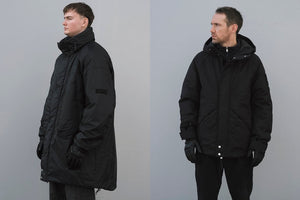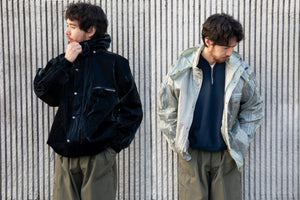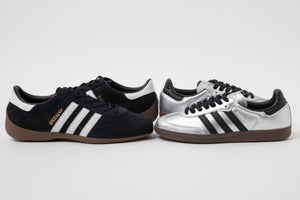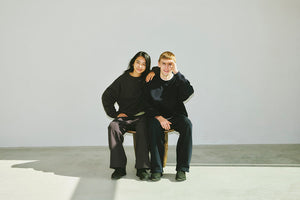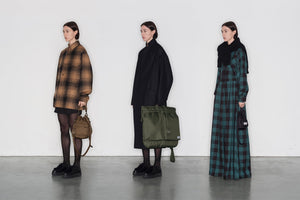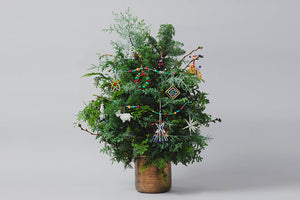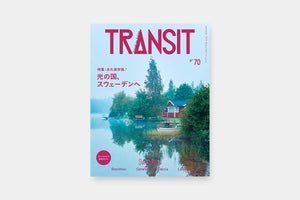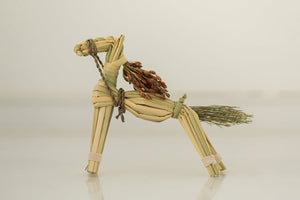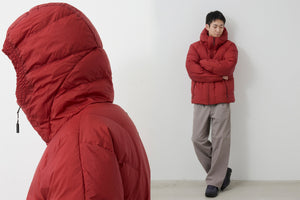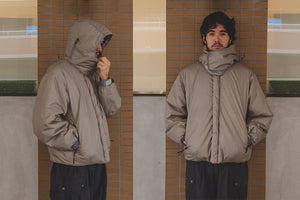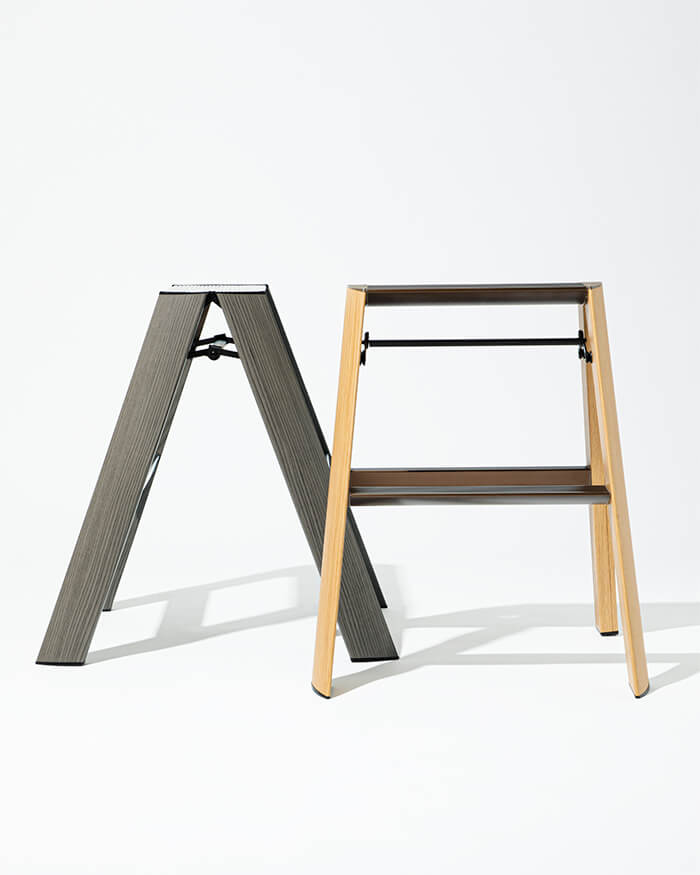特集記事

COVERCHORD EXCLUSIVE
SOPH. × nonnative
SOPHNATIVE
ROOM COLLECTION VOL.2
INTERVIEW with
清永浩文 × 藤井隆行
〈SOPH.〉と〈nonnative〉によるコラボプロジェクト〈SOPHNATIVE〉。
2回目となるカプセルコレクションが、6月24日(金)に発売。
〈SOPH.〉と〈nonnative〉によるコラボレーションプロジェクト〈SOPHNATIVE〉より、リアルな生活をテーマにしたカプセルコレクションがリリースされる。
前回のコレクションで大きな反響を呼んだ〈lucano〉の脚立に加え、1950~60年代のアメリカ、ロードサイドダイナーをイメージした、波佐見焼のカップとトレイ。どこか懐かしいアメリカンカレッジ風なプリントTシャツ。
年輪を重ねライフスタイルの変化を経た、清永浩文と藤井隆行が考える「生活」を共にしたいアイテムが並んだ。
本記事では両者にインタビューを敢行。二人の出会いから、今回のコラボレーションの経緯。お互いの考える「良い生活」を語ってもらった。
ライフスタイルにさりげなく取り込みたくなるような、本カプセルコレクションの発売は6月24日(金)。
清永浩文 × 藤井隆行
Talk about
“SOPHNATIVE”
長く続いた〈SOPH.〉と〈nonnative〉とのコラボレーションは、世界中のマインドセットを変えてしまったCOVID-19の影響か、自らの業界におけるステージの変化か、それに対する自然な抵抗か。いずれにせよ生活に結びつくコレクションへと変わっていった。掛け算方式の恣意的なバズを起こすためではなく、お互いのリアルを慣らしていく先に生まれるプロダクトについて、改めて考えを話し合うゆるやかな時間。すぐ近所に暮らす藤井の家族もふらりと訪れるといった、心地よい空気が流れる清永の葉山の新邸にて。とある土曜の朝。コーヒーを飲みながら。
―改まってしまいますが、お二人が出会ったきっかけを教えていただけますか?
清永:日韓ワールドカップの前後じゃなかったかな?
藤井:僕、あの頃毎週のようにJリーグ見に行ってました。で、終わったらみんなで飯食うみたいな。
清永:だからお互いブランドの人間として出会っているわけじゃない。
―プライベートのお付き合いがブランド同士のコミュニケーションに発展するって、すごく自然な流れに聞こえますが、思い返せばあの時代特有の考え方だったようにも思います。
藤井:僕は基本的に(業界の)先輩から声がかからないとやらないかな。こっちから「やりましょう」って頼んでも、人って断りにくいし。だから清さんが「そろそろなんかやる?」みたいに来るのを待ってた感もあったかな。
清永:自分の目線的には、縁がない人に自分からノックしたことはない。やっぱり縁とタイミングでコラボしてきたつもりです。
藤井:知らない人にアプローチしたことはないですか?
清永:うん。それは一貫していて、アーティストとコラボする時もまずは自分がその人のファンで、作品を所有してからオファーしている。初めまして、の時にコラボしましょうはないし、コミュニケーションとって仲良くなったタイミングで、だね。だからブランドとしてより、人とコラボしている感覚かな。あとはいくら仲良くても、世の中的に「これってなんの意味があるの?」と思われるようなことはしてこなかったつもり。
僕は気心知れた関係だと、なんでも相手に任せちゃうんです。お互いが探り合いながらぶつかり稽古する感じだと、良いものは生まれないから。漫才じゃないけど、自然な掛け合いができると相手への理解も早いし、物事が簡単に進む。そもそも面倒くさがりなところがあるから、とにかく楽していたいタイプなんです。

―知り合いの関係からスタートして、そこに至るまでに何かしらの理由があるということですね。一般的にコラボレーションという言葉から連想するのは、爆発力とか化学反応とか、大きなバズだったりすると思うのですが、〈SOPHNATIVE〉はお互いの緩やかな関係を表現している感覚があります。
藤井:そもそも、前回「2-step」を作った時も、ここで〈SOPH.〉と〈lucano〉の脚立を見て、僕の家の薄い木の床の色に合わせてもらったものだし、今回は清さんが「前に作ったマグカップがもっと欲しい」みたいなところから始まったんです。その時に今度は、この家の1階、玄関から続くグレーの床に合わせた脚立を作りたいと思ったんです。
清永:そうそう。きっかけはすごく単純。こっち(葉山)に家を建てたんで、東京で使っている予備のマグカップだけじゃ足りなくなったから作ったんだよね。―リアルに自分が使いたいもの、という観点でいえば、お二人が自分たちのブランドでマグカップを作ったことは意外でした。他に好きなものを買うこともできたはずですし、あまりご自身の生活にご自身のブランドを取り込むタイプではないように感じます。
清永:藤井くんはどうかわからないけど、割と自社でマグカップ作っているんです。たしかに、家で自分で作ったものに囲まれると、オンとオフが繋がってしまうから、心地よく感じられないこともあります。お客さんが来た時に、自社のマグカップでコーヒーを出すのも、ちょっとこそばゆい。でも、人と一緒にやると中和されて、自分のものじゃない感覚になる。
藤井:だけど、思い入れも生まれる。〈nonnative〉でロゴを入れるってほとんどないから、こういうデザインはコラボレーションでしか生まれない。逆に全部が新しい感覚かな。
―生活用品として、自分たちで作る、既存品で好きなものを探す、その境目ってどこにあるんでしょうか?
清永:既に前回の対談でも話していますが、服と同様に「餅は餅屋」みたいな目線はずっとあって、自社で似たようなものを作ることができても、結局自分はオリジナルのものを使い続けると思います。家のものも同じこと。素晴らしいインテリアやプロダクトデザイナー、建築家がたくさんいる中で、自然と自分で一線を引いていると思います。ただ脚立は、作るか作らないかのちょうど端境にある存在というか、アイデア次第で使えるな、と。
藤井:〈SOPH.〉が木目で作ったのは、目から鱗が落ちると言うか。〈長谷川工業〉の脚立はオフィスでも使っていたから、自分たちでオファーしてもいいと思ったけど、それは僕にとって清さんが餅屋になっていたから、まずはそこにお伺いを立てたというか(笑)
清永: その頃、〈長谷川工業〉とご縁があって一緒に作りましょう、って話になった時、ウチのロゴを入れたらお客さんも喜ぶかな、って思いがよぎったんです。でも、それじゃ仕事道具を家に置いている気がして、自分では使わないかな、と。じゃあ自分が本気で欲しい脚立ってなんだろうって考えたときに、木目調を思いついたんですよ。
藤井:でも、〈cado〉の空気清浄機もウォルナット柄で作ってましたけど、木目のツヤ感とか、インテリアに調和するかどうかは、かなりギリギリなところを攻めないと嘘くさく見えちゃうというか。バランスが難しいですよね。
清永:その発想って、たしか(テーブルに置いてあった〈SOPH.〉のティッシュボックスを手に持って)これからだよね。うち、ご存知の通りノベルティに力入れている会社で(笑)、日本を代表する製紙会社とティッシュを作る話になったとき「ボックスのデザインどうしましょうか?」となり。で、最初はグラフィックを入れたんだけど、みんなティッシュの存在を隠したくてウッドのカバーとか被せるなら、それって本末転倒じゃない?ってことで、ウッドのシリーズが始まったんだよね。
〈SOPH.〉も24年続けていると、当時20歳だった子が44歳になっているわけですよ。その時代、時代に必要なものを提案したいって気持ちはあるんですよね。自分が見てきた景色や、感じたものをアレンジして、なるべく飛ばしすぎずに。
藤井:僕は清さんとは10くらい歳が離れているけど、同じような気持ちかな。お客さんが「そういうの欲しかったんだよね」って思ってもらえたら。
―そもそも、お二人がブランドをデザインするにあたり、お客さんの年齢やライフスタイルとか、ペルソナを意識するようになったのはいつからですか? きっと、最初はご自身が欲しいものだけを作ってきたと思います。
藤井:僕もブランドも歳をとって、お客さんも成長していくと、ファッション以外に大事なことが増えてくるじゃないですか。家庭を持ったり、子どもがいたりすると、若い頃みたいに服にお金を費やせなくなってるし、飯代を節約してまで服を買うのも、ちょっとおかしい。
清永:そういったライフスタイルの変化に合ったものが提供できるといいなって思う。みんな仕事で毎日スーツを着るようになったら、カジュアルな服をたくさん買えるわけじゃない。でも、ずっとSOPH.を気にしてくれている人たちに、昔ほど買ってなくてもこの脚立は欲しいと思ってもらいたい。葉山の家を建てた時に、ハウスメーカーの担当者も「昔ほどはお店には行けなくなったけど、ふとしたタイミングで今もお世話になってます」って言われましたしね。
―清永さんと藤井さんは、年齢でいえば10歳くらい離れていますが、同じプロジェクトを継続したり、こうして家を行き来する仲です。何か、居心地のよい共通点があるのでしょうか?
清永:共通点? なんだろ。真似をしたり、勉強することもあるけど、感覚はずれてはないですよね。スタイルは違って見えるかもしれないけれど、好きな服の感じは似ているのかな?
藤井:ギラギラした部分があったとして、それを表に出している分量が近いというか……。
清永;ラグジュアリーは嫌いじゃないけど、あえて地味に表現するというか。欲はないように見せてるかもね。
藤井:もし、この家の照明がシャンデリアだったり、クッションがキラキラしていたら仲良くなってないかもしれない(笑)
清永:お互い、身の丈を理解しているかも知れないね。あと、卸先が同じお店が多い。あと、藤井くんも世の中をちょっと引いて見がちなタイプだよね。
藤井:そうですね、しかもど真ん中ではないかな。基本、目立ちたくはないです。
清永:前へ前へ行きたいとは思わないから、業界のフォワードではないよね。ボランチタイプ? でもちょっと中央じゃない。ずるい位置かもしれないですね。(笑)
藤井:そういうポジショニングは無意識に真似しているところもあります。家具やアートのセンスもそう。最初から僕はそんな知識もないし。あ、これにはこんな照明が合うんだ、とか、陶器はこれがいんだ、とか。
―清永さんは、そういった立ち位置やセンスで憧れた人はいらっしゃいますか?
清永:世代的にいろいろな先輩方に影響を受けたけど、限定した人はいないかもしれない。バラバラの集合体を編集している感覚ですね。
藤井:清さんみたいな人って、会ったことないかも。
藤井 隆行 - Takayuki Fujii
1976年生まれ。奈良県出身。武蔵野美術大学 空間演出デザイン学部を中退後、セレクトショップで経験を積み、2001年より〈nonnative〉デザイナーに就任。以来、独創的で洗練されたモノづくりを展開、〈nonnative〉の世界観を確立してきた。
https://nonnative.com
清永 浩文 - Hirofumi Kiyonaga
1967年大分県生まれ。洗練された日常着を目指し98年「SOPH.」設立 (2002年にSOPHNET.へ改名)。99年には架空のフットボールチームを想定した「F.C.Real Bristol」を、2008年にはメンズウェアの実験的プロジェクト「uniform experiment」をスタートするなどチャレンジングな戦略でシーンを牽引している。また、自身の名を冠した「KIYONAGA&CO.」をオンラインストア限定で展開中。
https://www.soph.net
https://kiyonagaandco.com
Interview & Text_Masayuki Ozawa
Translation_Yuko Caroline Omura
SOPHNATIVE
ROOM COLLECTION VOL.2
〈SOPHNET.〉と〈nonnative〉が不定期に行うコラボーレーションプロジェクト〈SOPHNATIVE〉より、「生活」をテーマにしたカプセルコレクションがリリースされる。
前回、特に大きな反響を呼んだ〈lucano〉とのコラボレーション脚立「2-step」には新色GRAYが登場。同じオーク柄ながら、よりシックな印象となりミニマルな空間にもフィットする。
長崎県波佐見町の陶器ブランド〈HASAMI〉へ制作を依頼したスタッキング可能なマグとトレイには新たにスモールサイズが登場。それぞれのライフスタイルにあわせたセレクトが可能となった。
〈nonnative〉のボディを使用したTシャツには、陶器シリーズ同様、アメリカンカレッジのスーベニアグッズ風のグラフィックをプリント。陶磁器をイメージして表現された落ち着いたプリントカラーに、上質なコットン素材。街着はもちろん自室でのリラックスタイムも快適に過ごせる1枚だ。
SOPHNATIVE
lucano
OAK 2-STEP
“隠さなくて良い踏み台”というコンセプトのもと、機能美あふれる脚立を展開する〈lucano〉とのコラボレーションモデル。本コレクションでは新色GRAYが登場。
SOPHNATIVE
lucano
OAK 2-STEP
Price_¥44,000
Color_BEIGE, GRAY
SOPHNATIVE
HASAMI
STACKING MUG / STACKING MUG SMALL

1950~60年代アメリカのロードサイドのダイナーで使われていた大衆食器のような、機能的で洗いやすく実用的なデザインのスタッキングマグカップ。長崎県波佐見町のブランド〈HASAMI〉による製作。
SOPHNATIVE
HASAMI STACKING MUG
Price_¥3,000
Color_WHITE
SOPHNATIVE
HASAMI STACKING MUG SMALL
Price_ ¥2,500
Color_WHITE
SOPHNATIVE
HASAMI
STACKING TRAY / STACKING TRAY SMALL

同じく〈HASAMI〉製のスタッキングトレイ。食卓で食器としても、リビングで小物入れとしても。
SOPHNATIVE
HASAMI STACKING TRAY
Price_¥2,500
Color_WHITE
SOPHNATIVE
HASAMI
STACKING TRAY SMALL
Price_¥2,000
Color_WHITE
SOPHNATIVE
UNIVERSITY TEE
〈nonnative〉のボディを使用したコットン天竺素材Tシャツ。アメリカンカレッジのスーベニアグッズをモチーフにしたグラフィックは、陶磁器をイメージした落ち着いたNAVYで表現。
SOPHNATIVE
UNIVERSITY TEE
Price_ ¥8,800
Color_WHITE
